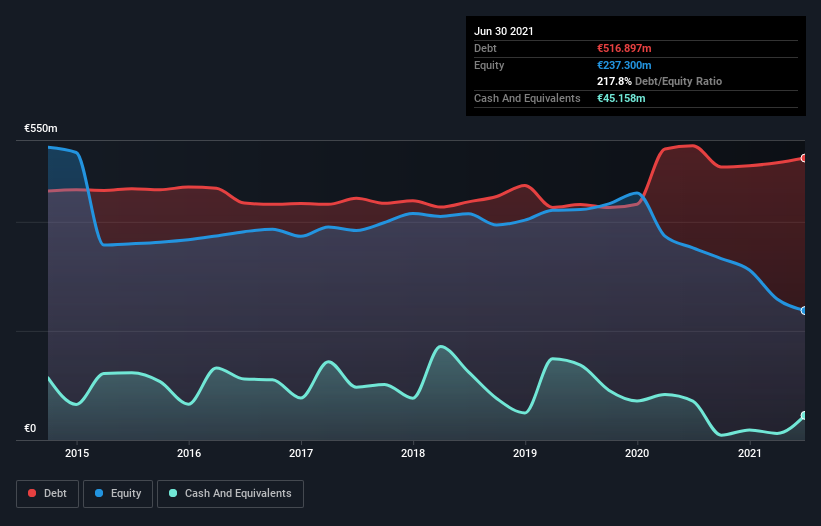Legendary fund manager Li Lu (who Charlie Munger backed) once said, 'The biggest investment risk is not the volatility of prices, but whether you will suffer a permanent loss of capital.' So it seems the smart money knows that debt - which is usually involved in bankruptcies - is a very important factor, when you assess how risky a company is. We can see that eDreams ODIGEO S.A. (BME:EDR) does use debt in its business. But the real question is whether this debt is making the company risky.
Why Does Debt Bring Risk?
Debt is a tool to help businesses grow, but if a business is incapable of paying off its lenders, then it exists at their mercy. In the worst case scenario, a company can go bankrupt if it cannot pay its creditors. While that is not too common, we often do see indebted companies permanently diluting shareholders because lenders force them to raise capital at a distressed price. Of course, debt can be an important tool in businesses, particularly capital heavy businesses. When we examine debt levels, we first consider both cash and debt levels, together.
Check out our latest analysis for eDreams ODIGEO
What Is eDreams ODIGEO's Net Debt?
As you can see below, eDreams ODIGEO had €516.9m of debt at June 2021, down from €539.6m a year prior. However, it also had €45.2m in cash, and so its net debt is €471.7m.

How Healthy Is eDreams ODIGEO's Balance Sheet?
Zooming in on the latest balance sheet data, we can see that eDreams ODIGEO had liabilities of €262.8m due within 12 months and liabilities of €538.0m due beyond that. On the other hand, it had cash of €45.2m and €47.1m worth of receivables due within a year. So its liabilities total €708.6m more than the combination of its cash and short-term receivables.
This is a mountain of leverage relative to its market capitalization of €835.7m. This suggests shareholders would be heavily diluted if the company needed to shore up its balance sheet in a hurry. There's no doubt that we learn most about debt from the balance sheet. But it is future earnings, more than anything, that will determine eDreams ODIGEO's ability to maintain a healthy balance sheet going forward. So if you want to see what the professionals think, you might find this free report on analyst profit forecasts to be interesting.
Over 12 months, eDreams ODIGEO made a loss at the EBIT level, and saw its revenue drop to €160m, which is a fall of 63%. That makes us nervous, to say the least.
Caveat Emptor
While eDreams ODIGEO's falling revenue is about as heartwarming as a wet blanket, arguably its earnings before interest and tax (EBIT) loss is even less appealing. Indeed, it lost €67m at the EBIT level. Considering that alongside the liabilities mentioned above does not give us much confidence that company should be using so much debt. Quite frankly we think the balance sheet is far from match-fit, although it could be improved with time. We would feel better if it turned its trailing twelve month loss of €124m into a profit. So we do think this stock is quite risky. When we look at a riskier company, we like to check how their profits (or losses) are trending over time. Today, we're providing readers this interactive graph showing how eDreams ODIGEO's profit, revenue, and operating cashflow have changed over the last few years.
When all is said and done, sometimes its easier to focus on companies that don't even need debt. Readers can access a list of growth stocks with zero net debt 100% free, right now.
New: Manage All Your Stock Portfolios in One Place
We've created the ultimate portfolio companion for stock investors, and it's free.
• Connect an unlimited number of Portfolios and see your total in one currency
• Be alerted to new Warning Signs or Risks via email or mobile
• Track the Fair Value of your stocks
This article by Simply Wall St is general in nature. We provide commentary based on historical data and analyst forecasts only using an unbiased methodology and our articles are not intended to be financial advice. It does not constitute a recommendation to buy or sell any stock, and does not take account of your objectives, or your financial situation. We aim to bring you long-term focused analysis driven by fundamental data. Note that our analysis may not factor in the latest price-sensitive company announcements or qualitative material. Simply Wall St has no position in any stocks mentioned.
Have feedback on this article? Concerned about the content? Get in touch with us directly. Alternatively, email editorial-team (at) simplywallst.com.
About BME:EDR
eDreams ODIGEO
Operates as an online travel company in France, Southern Europe, Northern Europe, and internationally.
Solid track record and good value.
Similar Companies
Market Insights
Community Narratives



